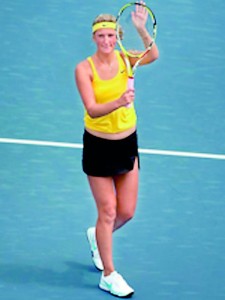US Open and ‘video’ espionage
View(s):‘Cincinnati Southern and western’ and the current ‘Salem- Open’ are the immediate warm ups for the US Open. Many players save themselves skipping ‘Salem-Open for the ‘Big Apple’s Grand-Slam, the US Open.Two Americans reach the finals
This year’s Cincinnati will be remembered for Azarenka’s feat and Serena William’s ‘fight to the end’ performance in the finals. Azarenka was a set down to Serena Williams and was struggling in the start of the second set. The manner in which she turned the match around, was amazing. Rising to the occasion, she stopped Serena’s domination and made history. It was easily the best match of the

Victoria Azarenka
tournament. It was also a very exiting match. Serena Williams stood ground and proved to be a great competitor and a good sportsperson. After all it takes two to make a good match.
In the men’s singles another American, lost in the finals. Nadal prevailed over America’s John Isner who won more points than the winner but played two bad tie breaks. After Cincinnati, Isner went up in the ATP ranking to slot 14. In the Semi finals, Isner did somewhat a similar act as Azarenka when he beat Juan del Potro producing the best match in the men’s side. His presence in the finals is probably a big boost to US Tennis. Tennis development in US is under the microscope these days. They would like to see a quick turn-around. For US, Isner is a good replacement for the retired Andy Roddick.
Video espionage–new weapon?
This is not about CIA, KGB or for that matter, the whereabouts of ‘Snowden’. Video analysis in Sports teaching is considered to be an effective tool if a player can see the action within 20 seconds of doing it. Many software are available in the market and I personally have two in my computer. But what do we call using video to see how the opponent’s are playing – ‘Video-espionage’? For some time players in the world ranking have been using video to see the patterns and behavior of their immediate opponents. If you are world’s number one like Djokovic, how can he escape being studied through Video? TV stations buy rights to broadcast from event organizers, with that his videos come into the public domain.
Players show patterns, consciously or by habit. This is their comfort zone behavior. However there is no guarantee a player will stay within those patterns for the next match. It is common knowledge that many watch their immediate opponents a day or two before the match. Whether this is fair or not, I do not know but I can only say it is available to all. Coaches use this to assist players. So far no one has blown the whistle on this. Even if they make a rule, it would be a ‘mission impossible’ to implement it.
 When the famous trio of India – Ramanathan Krishnan, Jaideep Mukherjee and Premjit Lall were manning the Davis cup and took India into the semi-finals, an Indian old timer told us an interesting observation. He said, “the magic of Krishnan is the art of doing nothing special and make everything happen. Jaideep is agile and he is everywhere at the same time. So the opponents do not know how to pin him down. Premjit is like an unshakable wall, difficult climb and too strong to break.” The speaker was Akthar Ali another from the Calcutta South Club who played Wimbledon. Naresh Kumar is also from the Calcutta South Club was the aristocrat Captain of that Indian Davis cup team. So, reading, analyzing and branding players is an old game, now played with Video
When the famous trio of India – Ramanathan Krishnan, Jaideep Mukherjee and Premjit Lall were manning the Davis cup and took India into the semi-finals, an Indian old timer told us an interesting observation. He said, “the magic of Krishnan is the art of doing nothing special and make everything happen. Jaideep is agile and he is everywhere at the same time. So the opponents do not know how to pin him down. Premjit is like an unshakable wall, difficult climb and too strong to break.” The speaker was Akthar Ali another from the Calcutta South Club who played Wimbledon. Naresh Kumar is also from the Calcutta South Club was the aristocrat Captain of that Indian Davis cup team. So, reading, analyzing and branding players is an old game, now played with Video
US-Open and the pressure to win
Pressure is bad for match performance and development. Pressure is when one considers good performance is not good enough but winning is the only thing. This will bring the player’s performance down. Right now I feel Djokovic is a victim of this syndrome. I have always noticed this pressure syndrome affects the top, during the time of the US-Open. As often mentioned by me, the top rung is also tired, performing right through the year. They know that they can be victims of hunting parties during the US season. Djokovic could bounce back at the US-Open.
2013 Sri Lanka Nationals
The matches are in the semi-final stage. In doubles, a veteran has entered the quarter finals – Rohan de Silva. In the junior event, even the ‘overseas trained’ players are only proving marginally better than the locals. The reason behind average development is the lack of ‘exposure’. Exposure educates and matures players to survive the ever changing situations in competitive Tennis. Teaching instructions do not educate or give exposure to match situations. Many countries have this problem, India with its many Tennis academies and US, with decades of ‘academy culture’ do not seem to produce anything great. At present it is Europe that is showing strength in the world of Tennis, especially the former eastern bloc countries.
<George Paldano, former international player; Accredited Coach of Germany, ITF and USPTR; National, Davis Cup and Federation Cup Coach –georgepaldano@yahoo.com>
comments powered by Disqus

